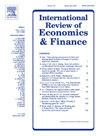CEO tenure: Evidence from U.S. public firms
IF 5.6
2区 经济学
Q1 BUSINESS, FINANCE
引用次数: 0
Abstract
This study investigates the determinants of CEO tenure in U.S. public firms using a survival analysis framework. Using a dataset of 4833 CEO tenures from 2445 firms (1992–2018), the analysis employs a Cox proportional hazards model to examine how CEO traits, internal promotions, and firm financial characteristics influence turnover. CEOs in the sample typically start at age 52 and exit around age 59, serving an average tenure of 7.6 years. Only 4 % of the CEOs are female. A substantial number remain in office beyond age 66, suggesting that many firms permit executives to continue serving past conventional retirement ages. Survival analysis shows that older CEOs are more likely to retire voluntarily and less likely to be dismissed, consistent with career life-cycle patterns. Internal appointments are associated with substantially lower risks of both forced and voluntary turnover, reflecting reduced information asymmetry and potential entrenchment effects. Among firm-level factors, higher intangible assets and financial losses increase turnover likelihood, whereas greater leverage stabilizes tenure. Turnover patterns also vary by industry: regulated sectors experience fewer dismissals, while technology sectors show greater forced turnover. Overall, the findings suggest that observable CEO and firm characteristics at the time of appointment shape the baseline conditions of the CEO–firm relationship and provide predictive signals about turnover risk and tenure duration.
CEO任期:来自美国上市公司的证据
本研究使用生存分析框架调查美国上市公司CEO任期的决定因素。利用来自2445家公司(1992-2018)的4833名CEO任期数据集,该分析采用Cox比例风险模型来检验CEO特质、内部晋升和公司财务特征如何影响离职。样本中的ceo一般在52岁入职,59岁左右离职,平均任期为7.6年。只有4%的ceo是女性。相当多的高管在66岁以上仍在任职,这表明许多公司允许高管在超过常规退休年龄后继续任职。生存分析显示,年龄较大的ceo更有可能自愿退休,被解雇的可能性更小,这与职业生命周期模式一致。内部任命大大降低了被迫和自愿离职的风险,反映了信息不对称的减少和潜在的堑壕效应。在公司层面的因素中,更高的无形资产和财务损失增加了离职的可能性,而更高的杠杆则稳定了任期。离职模式也因行业而异:受监管行业的解雇较少,而科技行业的被迫离职则更多。总体而言,研究结果表明,在任命时可观察到的CEO和企业特征塑造了CEO -企业关系的基线条件,并提供了关于离职风险和任期持续时间的预测信号。
本文章由计算机程序翻译,如有差异,请以英文原文为准。
求助全文
约1分钟内获得全文
求助全文
来源期刊
CiteScore
7.30
自引率
2.20%
发文量
253
期刊介绍:
The International Review of Economics & Finance (IREF) is a scholarly journal devoted to the publication of high quality theoretical and empirical articles in all areas of international economics, macroeconomics and financial economics. Contributions that facilitate the communications between the real and the financial sectors of the economy are of particular interest.

 求助内容:
求助内容: 应助结果提醒方式:
应助结果提醒方式:


